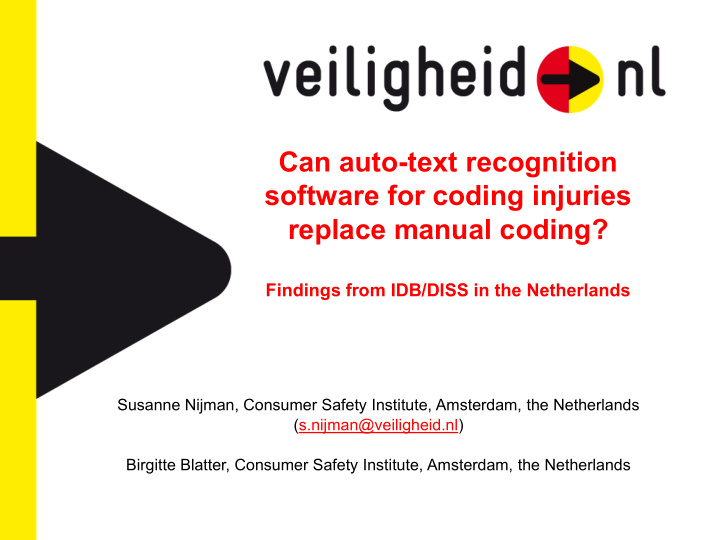



Can auto-text recognition software for coding injuries replace manual coding? Findings from IDB/DISS in the Netherlands Susanne Nijman, Consumer Safety Institute, Amsterdam, the Netherlands (s.nijman@veiligheid.nl) Birgitte Blatter, Consumer Safety Institute, Amsterdam, the Netherlands
What is VeiligheidNL? Expertise center for safe behaviour in a safe environment WHAT : our approach Monitoring trends and causes of injuries HOW : we make sure that safe behaviour is natural WHY : A safe home, travel Development and work of inter- environment, ventions to for everybody stimulate safe behaviour by stimulating people in a positive way We share knowledge with several target groups
Dutch Injury Surveillance System (DISS) • Since 1997 • Registration of injuries at EDs • Representative, 14 of 87 EDs, 11% of visits • Extrapolation to national figures • Injuries/intoxications: cause (home and leisure, work, sport, traffic, violence, self-harm) + reasons • Annual upload to European Injury DataBase (IDB)
Background • Until a few years ago all variables in IDB/DISS (such as injury mechanism, product involved, type of injury and body part involved) were coded manually by the staff of the ED • To reduce the administrative burden on EDs we developed a system for automatic text recognition software
What do we ask from EDs? Information that is already registered in their own Hospital Information System: • Personal characteristics: age, gender and postal code • Diagnosis • Hospitalization yes/no Additional information in open text fields (integrated in their hospital information system) for all injuries and intoxications: • What happened? • Where/when dit it happen? • What products were involved?
Aim Can automatic text recognition software for coding injuries replace manual coding? Examples: 1. Car driver, collision against tree, high speed accident • Desired output: • Injury mechanism: contact with object • Products involved: car, tree 2. Patient found intoxicated, used alcohol and speed • Desired output: • Injury mechanism: chemical mechanism • Products involved: alcohol, speed
Methods • After assessment of several tools, we chose IBM SPSSModeler • We taught the system from scratch how to code information on accidents and injuries • All possible words were classified into libraries and the system was taught how to interpret sentences • Comparison: IBM Modeler out – manual check out
VeiligheidNL - IBM Lotus Notes IBM Lotus Notes: Manuel check / corrections
VeiligheidNL - IBM Lotus Notes Analysis manual Learning mechanism corrections Comparison IBM Lotus Notes: Manuel check / corrections Modeler out – Manuel check out
Findings: 81% of injury mechanism coded correctly
Analysis
Next steps • Start with analysis of false and unknown cases (largest numbers and/or percentage false): manual text analysis, search for patterns • Make adjustments in SPSS Modeler based on analysis of false and unknown cases • Check if adjustments have the desired effect
Conclusions (1) • It takes a lot of time to prepare proper text analysis • For only products we have imported 9.000 terms (including synonyms and misspelled words) • Words with double meaning cause difficulties (takes a lot of time)
Conclusions (2) • First analysis showed: 81% of injury mechanism coded correctly • We still check every record manually and correct if necessary • The work that is done by the software makes coding at VeiligheidNL easier • In the future we will be able to reduce the number of checks • And most important: we have managed to reduce the administrative burden for ED’s!
Thanks for your attenion! Questions? Susanne Nijman, Consumer Safety Institute, Amsterdam, the Netherlands s.nijman@veiligheid.nl Birgitte Blatter, Consumer Safety Institute, Amsterdam, the Netherlands b.blatter@veiligheid.nl www.veiligheid.nl/en
Recommend
More recommend